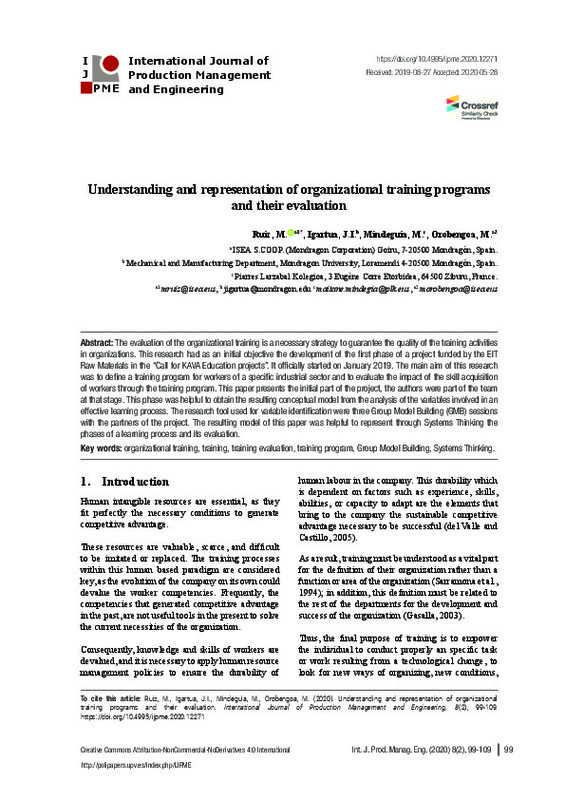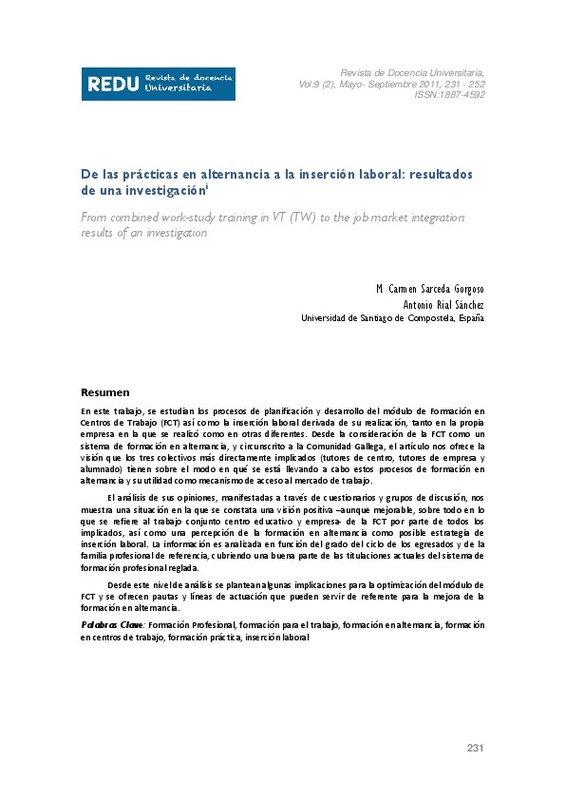Agnaia, A.A. (1996). Assessment of Management Training Needs and Selection for Training: The Case of Libyan Companies. International Journal of Manpower, 17(3), 31-52. https://doi.org/10.1108/01437729610119504
Al-Khayyat, R. (1998). Training and Development Needs Assessment: A Practical Model for Partner Institutes. Journal of European Industrial Training, 22(1), 18-28. https://doi.org/10.1108/03090599810197658
Alliger, G.M., Tannenbaum, S.I., Bennett, W., Traver, H., Shotland, A. (1997). A Meta- Analysis of the Relations among Training Criteria. Personnel Psychology, 50, 341-58. https://doi.org/10.1111/j.1744-6570.1997.tb00911.x
[+]
Agnaia, A.A. (1996). Assessment of Management Training Needs and Selection for Training: The Case of Libyan Companies. International Journal of Manpower, 17(3), 31-52. https://doi.org/10.1108/01437729610119504
Al-Khayyat, R. (1998). Training and Development Needs Assessment: A Practical Model for Partner Institutes. Journal of European Industrial Training, 22(1), 18-28. https://doi.org/10.1108/03090599810197658
Alliger, G.M., Tannenbaum, S.I., Bennett, W., Traver, H., Shotland, A. (1997). A Meta- Analysis of the Relations among Training Criteria. Personnel Psychology, 50, 341-58. https://doi.org/10.1111/j.1744-6570.1997.tb00911.x
Alsina, M.I.B., Rodriguez, F.A.C. (2001). Estrategias de evaluación de los aprendizajes centradas en el proceso. Revista española de pedagogía ,25-48.
Alvarez, K., Salas, E., Garofano, C.M. (2004). An integrated model of training evaluation and effectiveness. Human resource development Review, 3(4), 385-416. https://doi.org/10.1177/1534484304270820
Aragón-Sánchez, A., Barba-Aragón, I., Sanz-Valle, R. (2003). Effects of training on business results. The International Journal of Human Resource Management, 14(6), 956-980. https://doi.org/10.1080/0958519032000106164
Arnold, R.D., Wade, J.P. (2015). A definition of systems thinking: A systems approach. Procedia Computer Science, 44(2015), 669-678. https://doi.org/10.1016/j.procs.2015.03.050
Bassi, L.J., Ludwig, J., McMurrer, D.P., Van Buren, M. (2002). Profiting from learning: firm-level effects of training investments and market implications. Singapore Management Review, 24(3), 61-80.
Bee, F., Bee, R. (1997). Training Needs Analysis and Evaluation. London: Institute of Personnel and Development.
Brown, K.G., Gerhardt, M.W. (2002). Formative evaluation: An integrative practice model and case study. Personnel Psychology, 55, 951-983. https://doi.org/10.1111/j.1744-6570.2002.tb00137.x
Buckley, R., Caple, J. (1991). La formación: Teoría and práctica. Madrid: Díaz de Santos.
del Valle, I.D., Castillo, M.Á.S. (2005). Problemas y propuestas de medición de la formación en la empresa/Problems and measuring proposals for company training. Cuadernos de estudios empresariales, 15, 27.
Desimone, R.L., Werner, J.M., Harris, D.M. (2002). Human resource development. Cincinnati, OH: South Western.
Dickenson, P., Blundell, B. (2000). Transferring Quality Management Experience to the Russian Aerospace Industry. Total Quality Management, 11(3), 319-27. https://doi.org/10.1080/0954412006838
Foot, M., Hook, C. (1996). Introducing Human Resource Management. Singapore: Longman.
Frazis, H., Gittleman, M., Horrigan, M., Joyce, M. (1998). Results from the 1995 Survey of Employer-Provided Training. Monthly Labor Review, 121(6), 3-13.
Gasalla, J.M. (2003). Marketing de la formación de directivos: el nuevo directivo en la cultura del aprendizaje. Madrid: Pirámide.
Goldstein, I.L. (1993). Training in Organizations. Pacific Grove, CA: Brooks/Cole.
Gray, G.R., Hall, M.E. (1997).Training Practices in State Government Agencies. Public Personnel Management, 26(2), 187-203. https://doi.org/10.1177/009102609702600203
Hamblin, A.C. (1974). Evaluation and Control of Training. Maidenhead: McGraw-Hill.
Hannum,W., Hansen, C. (1989). Instructional systems development in large organizations. Englewood Cliffs, NJ: Educational Technology Publications.
Herrero, P.P. (2000). Evaluación del impacto de la formación de las organizaciones. Educar, (27), 119-133.
Holton, E.F. (2000). Large-scale Performance-Driven Training Needs Assessment. Public Personnel Management, 29(2), 249-67. https://doi.org/10.1177/009102600002900207
Hoppenbrouwers, S., Rouwette, E. (2012). A dialogue game for analysing group model building: framing collaborative modelling and its facilitation. International Journal of Organisational Design and Engineering, 2(1), 19-40. https://doi.org/10.1504/IJODE.2012.045905
Kaufman, R., Keller, J.M. (1994). Levels of Evaluation: Beyond Kirkpatrick. Human Resource Development Quarterly, 5(4), 371-80. https://doi.org/10.1002/hrdq.3920050408
Kenney, J., Donnelly, P. (1976). Manpower Training and Development. Londres: Harrap.
Kirkpatrick, D. (1997). Revisando las Grandes Ideas. Training & Development Digest, September: 28-36.
Kirkpatrick, J.D., Kirkpatrick, W.K. (2016). Kirkpatrick's four levels of training evaluation. Association for Talent Development.
Kraiger, K., Ford, J.K., Salas, E. (1993). Application of cognitive, skill-based, and affective theories of learning outcomes to new methods of training evaluation. Journal of Applied Psychology, 78, 311-328. https://doi.org/10.1037/0021-9010.78.2.311
Legare, T.L. (1999). Defining Training Roles and Responsibilities at Partners Healthcare System. National Productivity Review, 19(1), 5-13. https://doi.org/10.1002/npr.4040190103
McGehee, R., Thayere, J. (1961) Training in Business and Industry. New York: John Wiley.
Moller, L., Mallin, P. (1996). Evaluation practices of instructional designers and organizational support or barriers. Performance Improvement Quarterly, 9(4), 82-92. https://doi.org/10.1111/j.1937-8327.1996.tb00740.x
Nadler, Z., Nadler, L. (2012). Designing training programs. Routledge. https://doi.org/10.4324/9780080503974
Oberman, G. (1996). An Approach for Measuring Safety Training Effectiveness. Occupational Health & Safety, 65(12), 48-58.
O'Neill, M. (1998). Cómo enfocar la evaluación de la formación. Info-line (American Society for Training and Development), 1(special issue), 1-18.
Phillips, J.J. (2012). Return on investment in training and performance improvement programs. Routledge. https://doi.org/10.4324/9780080516257
Phillips, J.J., Phillips, P.P. (2016). Handbook of training evaluation and measurement methods. Routledge. https://doi.org/10.4324/9781315757230
Pineda, P. (1998). El reto de evaluar la formación en la empresa: Herramientas and soluciones. Capital Humano, 111, 32-6.
Plant, R.A., Ryan, R.J. (1992).Training Evaluation: A Procedure for Validating an Organizations Investment in Training. Journal of European Industrial Training, 16(10), 22-38. https://doi.org/10.1108/03090599210021720
Sarramona, J., Colom, A, Vázquez, G (1994). Estrategias de formación en la empresa. Narcea.
Selmer, J. (2000). A Quantitative Needs Assessment Technique for Cross-Cultural Work Adjustment Training. Human Resource Development Quarterly, 11(3), 269-282. https://doi.org/10.1002/1532-1096(200023)11:3%3C269::AID-HRDQ5%3E3.0.CO;2-6
Spitzer, D.R. (1999). Embracing evaluation. Training, 36(6), 42-47.
Swanson, R.A. (2005). Evaluation, a state of mind. Advances in Developing Human Resources, 7(1), 16-21. https://doi.org/10.1177/1523422304272078
Tannenbaum, S.I., Woods, S.B. (1992). Determining a Strategy for Evaluating Training: Operating within Organizational Constraints. Human Resource Planning, 15(2), 63-82.
Wang, G.G., Wilcox, D. (2006). Training evaluation: knowing more than is practiced. Advances in Developing Human Resources, 8(4), 528-539. https://doi.org/10.1177/1523422306293007
[-]












